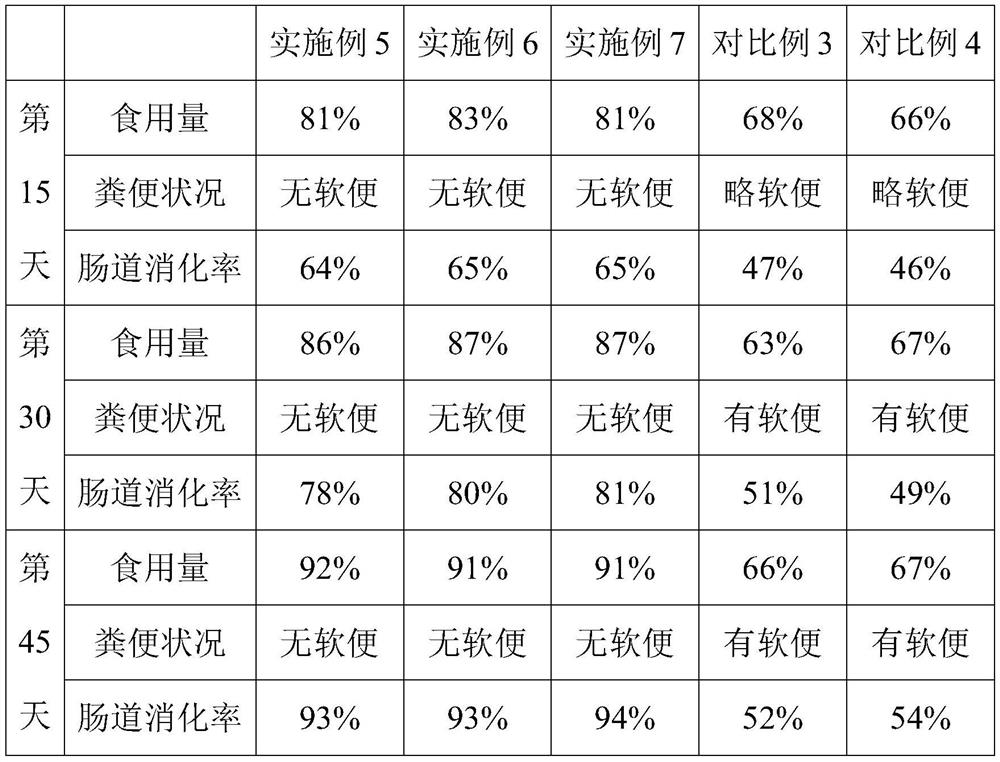Compound enzymatic hydrolysate for pet food and preparation process thereof
A technology of pet food and enzymatic hydrolyzate, applied in the field of enzymatic decomposition, can solve the problems of inability to guarantee whether pets like it, poor palatability, and difficulty in changing pet eating behavior
- Summary
- Abstract
- Description
- Claims
- Application Information
AI Technical Summary
Problems solved by technology
Method used
Image
Examples
Embodiment 1
[0040] A compound enzymatic hydrolyzate and its preparation:
[0041] 1) Preparation of protein hydrolyzate
[0042] Conditioning: Take meat, meat powder and other protein raw materials, grind them, pour them into the protein reaction kettle, heat up to 85°C for conditioning, and last for 15 minutes. This step can stretch the protein macromolecular structure and allow proteases to better contact the protein Structural reaction points, so that the protein hydrolysis reaction can be carried out more comprehensively;
[0043] First-level enzymatic hydrolysis: add pepsin to the reaction kettle, react at 50°C for 30 minutes, and the pH is 3;
[0044] Secondary enzymatic hydrolysis: The above enzymatic hydrolyzate was subjected to 300W ultrasonication for 2 minutes, and the enzymatic hydrolysis condition was 60°C for 15 minutes, and then the flavor enzyme was added to the reactor to continue the enzymatic hydrolysis reaction.
[0045] 2) Preparation of starch hydrolyzate
[0046]...
Embodiment 2
[0053] A compound enzymatic hydrolyzate and its preparation:
[0054] 1) Preparation of protein hydrolyzate
[0055]Conditioning: Take meat, meat powder and other protein raw materials, grind them, pour them into the protein reaction kettle, heat up to 80°C for conditioning, and last for 30 minutes. This step can make the protein macromolecular structure stretch out, so that the protease can better contact the protein Structural reaction points, so that the protein hydrolysis reaction can be carried out more comprehensively;
[0056] First-level enzymatic hydrolysis: add trypsin to the reaction kettle, react at 53°C for 18 minutes, and the pH is 2;
[0057] Secondary enzymatic hydrolysis: The above enzymatic hydrolyzate was subjected to 250W ultrasound for 2 minutes, and the enzymatic hydrolysis condition was 58°C for 16 minutes, and then papain was added to the reactor to continue the enzymatic hydrolysis reaction.
[0058] 2) Preparation of starch hydrolyzate
[0059] Fir...
Embodiment 3
[0066] A compound enzymatic hydrolyzate and its preparation:
[0067] 1) Preparation of protein hydrolyzate
[0068] Conditioning: Take meat, meat powder and other protein raw materials, grind them, pour them into the protein reaction kettle, heat up to 80°C for conditioning, and last for 30 minutes. This step can make the protein macromolecular structure stretch out, so that the protease can better contact the protein Structural reaction points, so that the protein hydrolysis reaction can be carried out more comprehensively;
[0069] First-level enzymatic hydrolysis: Add pepsin and trypsin to the reaction kettle, react at 60°C for 15 minutes, and the pH is 5;
[0070] Secondary enzymatic hydrolysis: The above enzymatic hydrolyzate was subjected to 300W ultrasonication for 2 minutes, and the enzymatic hydrolysis condition was 50°C for 30 minutes, and then the compound animal proteolytic enzyme was added to the reactor to continue the enzymatic hydrolysis reaction.
[0071] 2...
PUM
 Login to View More
Login to View More Abstract
Description
Claims
Application Information
 Login to View More
Login to View More - R&D
- Intellectual Property
- Life Sciences
- Materials
- Tech Scout
- Unparalleled Data Quality
- Higher Quality Content
- 60% Fewer Hallucinations
Browse by: Latest US Patents, China's latest patents, Technical Efficacy Thesaurus, Application Domain, Technology Topic, Popular Technical Reports.
© 2025 PatSnap. All rights reserved.Legal|Privacy policy|Modern Slavery Act Transparency Statement|Sitemap|About US| Contact US: help@patsnap.com

